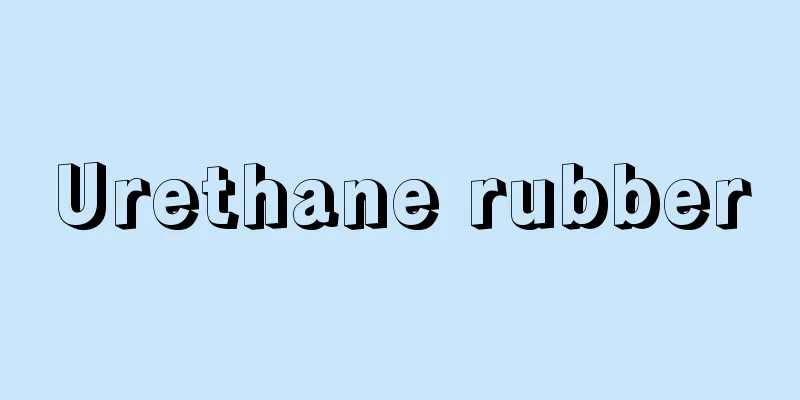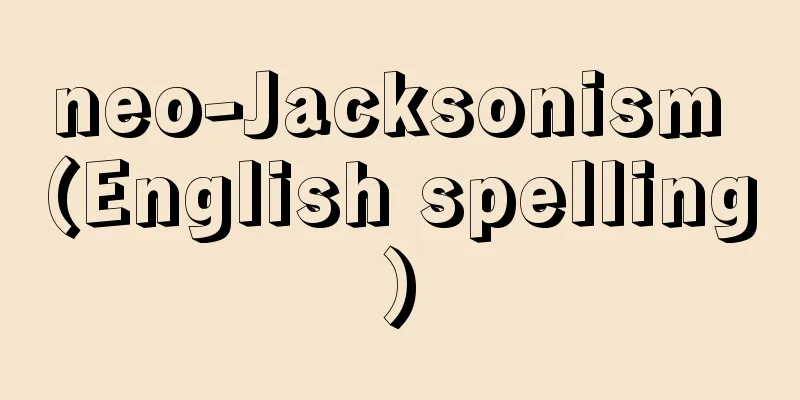Urethane rubber

|
A type of special synthetic rubber. It is also called polyurethane rubber or urethane elastomer. Its abbreviation according to ASTM International (formerly the American Society for Testing and Materials) standards is U. The foam is called urethane foam. The manufacturing method is to first synthesize a prepolymer of appropriate molecular weight by polyaddition reaction of liquid polyether diol or polyester diol with hydroxyl groups at both ends and diisocyanate. The prepolymer has a urethane bond -RNHCOOR'- in the molecular chain, hence the name. The polyether type is abbreviated as EU, and the polyester type is abbreviated as AU (ASTM compliant). There are three types of rubbers, depending on the molding method: (1) cast type, which is cast-molded, (2) millable type, which is processed like normal rubber, and (3) thermoplastic type, which is injection-molded. Type (1) is called liquid rubber, and is a liquid prepolymer with hydroxyl or isocyanate groups at both ends, which crosslinks with polyisocyanate, polyamine, polyol, water, etc. to form a three-dimensional network structure rubber. When water is used as a crosslinking agent and a foaming agent is added to the raw material, foamed polyurethane is obtained. Type (3) is called thermoplastic elastomer, and is a long-chain polyurethane that can be molded like plastic. Type (1) is the most widely used, and a wide variety of rubbers are made, including soft and hard rubbers, sponges, and foams. It has excellent mechanical strength and abrasion resistance, high load-bearing capacity, and good ozone and oil resistance. However, it has poor heat and chemical resistance, and caution is required against hydrolysis in the polyester type. Applications include cushioning materials for automobiles, bedding and furniture, shock-absorbing and insulating materials for equipment and civil engineering and construction, shoe soles, belts, hoses, packing, solid tires for low-speed transportation, and other industrial rubber products. [Kazuyoshi Fukuda] [Reference item] | |Source: Shogakukan Encyclopedia Nipponica About Encyclopedia Nipponica Information | Legend |
|
特殊合成ゴムの一種。ポリウレタンゴムあるいはウレタンエラストマーともよばれる。ASTMインターナショナル(旧、アメリカ材料試験協会)の規格による略称はU。その発泡体はウレタンフォームという。製法は、まず両末端にヒドロキシ基をもつ液状のポリエーテルジオール、またはポリエステルジオールとジイソシアナートの重付加反応によって適当な分子量のプレポリマーを合成する。プレポリマーは分子鎖にウレタン結合-RNHCOOR'-をもつので、この名称がある。ポリエーテルタイプはEU、ポリエステルタイプはAUと略称(ASTM準拠)。 成形法によって、(1)注形加工するキャストタイプ、(2)通常のゴムのように加工するミラブルタイプ、および(3)射出成形加工する熱可塑性タイプの3種類がある。(1)のタイプは、液状ゴムとよばれ、両末端がヒドロキシ基あるいはイソシアナート基の液状プレポリマーであり、それぞれ、ポリイソシアナートあるいはポリアミン、ポリオール、水などで架橋して三次元網目構造のゴムとなる。水が架橋剤および原料に発泡剤を加えた場合など、発泡ポリウレタンが得られる。(3)のタイプは、熱可塑性エラストマーとよばれ、長鎖状ポリウレタンであり、プラスチックのように成形できる。(1)のタイプがもっとも多く使われ、軟質から硬質に至るゴムやスポンジ、フォームなど多様な品種のゴムがつくられている。機械的強度や耐摩耗性が優れ、大きな耐荷重性があり、耐オゾン性や耐油性もよい。しかし、耐熱性や耐薬品性が劣り、ポリエステル形は加水分解に注意が必要である。用途は自動車や寝具・家具用のクッション材、機器や土木建築用の緩衝・断熱材、靴底、ベルト、ホース、パッキング、低速運搬用ソリッドタイヤ、その他の工業用ゴム製品などである。 [福田和吉] [参照項目] | |出典 小学館 日本大百科全書(ニッポニカ)日本大百科全書(ニッポニカ)について 情報 | 凡例 |
>>: Wool colour standard solution - Wool colour standard solution
Recommend
Outdoor market - Rojo
An outdoor location where meteorological observat...
Rhus chinensis Mill.
A deciduous tree of the Anacardiaceae family that ...
Jagang Province - Jikodo
A province in the northeastern part of North Kore...
Both sides have medium sized circular tombs
A type of tomb. It refers to a tomb in which a squ...
Nagoya Railroad - Nagoya Railroad
A private railway company. Founded in 1894 as Aich...
Rebel - Gyakuto
…He is famous for his involvement in the banning ...
Double Yang
〘Noun〙 (meaning the number nine, the extreme posit...
Roan Ozawa
Year of death: July 11, 1801 (August 19, 1801) Yea...
Shimooka Renjo - Shimooka Renjo
Commercial photographer. Born in Shimoda, Izu. Al...
FEM - FEM
《 finite element method 》⇒finite element method So...
M - M
It is the 13th letter of the English alphabet. It...
Kama-bane-sakukei - Kama-bane-sakukei
...A general term for a group of birds in the fam...
Submarine tunnel - Kaitei tunnel (English spelling) submarine tunnel
A tunnel built under the sea to connect straits, c...
Beckford, William
Born: October 1, 1760, Fonthill Gifford, Wiltshire...
Microsorium buergerianum (Miq.) Ching
An evergreen perennial fern of the Polypodiaceae f...









